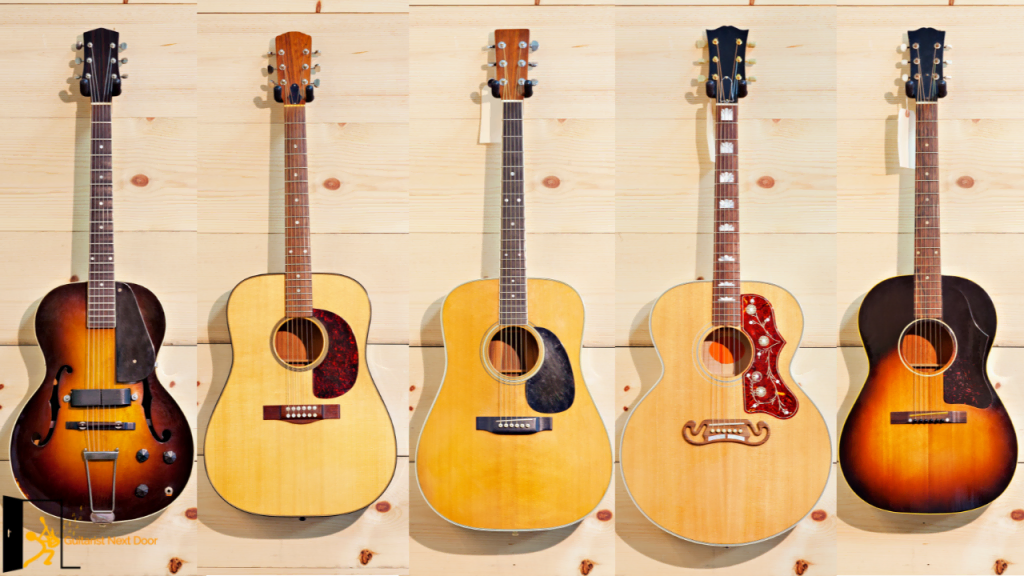Last Updated on January 9, 2024 by Justin Thomas

Author: Santiago Motto

Editing & Research: Teemu Suomala
Sometimes, guitar players lose sight that, underneath all the gimmicks, marketing, and bright colors, guitars are organic instruments made of wood.
Moreover, the guitar wood continues to be affected by the humidity around it just like it did before being harvested.
So, humidity changes affect every stringed instrument including our electric and acoustic guitars in many ways. If we do nothing about it, they might even crack, loosen glue joints, deform, or be unusable.
Does this sound scary? Well, it kind of is, but worry not because we’re here to solve it once and for all.
Read on and keep your guitar safe and sound all year long with minimal effort.
Ideal Humidity for Guitar – What’s Best for Your Guitar?

According to Taylor Guitars, the ideal humidity level for your guitar is 45-55% relative humidity.
This ideal humidity number applies to all and every guitar, electric guitars, hollow body guitars; from the most expensive pre-war Martin to the cheapest laminated Epiphone to the Squier copy you keep hanging from the wall so your playing-guitar friends can sing “La Bamba” with it.
Check our favorite Martin guitars and High-end acoustic guitars.
Speaking of hanging from a wall and ideal humidity, the perfect scenario is to keep your guitar inside a microclimate sitting comfy in its factory case. Also, the case will act like a temperature-controlled room. According to Fender, the ideal temperature is between 66 and 77°F (19 to 25°C).
That being said, if you’re like me, you probably like having your favorite acoustic guitars ready to go at all times. Yes, we all know that if the guitar is looking at you from a stand in a room you’re in a lot, you’re way more likely to pick it up and play it than if it is inside its case.
Remember that acoustic guitars build from solid woods are more sensitive to humidity and temperature changes than laminate wood acoustic guitars. Find more info about laminate vs solid wood acoustic guitars here.
This also impacts the strings since relative humidity is basically water vapor, and you’ll be changing strings more often.
So, the best for your acoustic guitar (or electric guitar) is to control the room it is in and provide the optimum conditions in humidity and temperature.
What Happens to Your Guitar In Different Humidities?
Some of the symptoms you’re about to see can be discovered with visual sighting and others like loose glue joints need professional eyes.
What Happens to a Dry Guitar?
Let’s just get started with a basic concept: dry wood shrinks. So when your guitar is exposed to under 40% relative humidity, these kind of easy-to-spot symptoms can be noticed:
- Razorblade frets – Have you ever picked up a guitar and felt that the frets were piercing the palm of your hand or your thumb? Well, as the guitar’s neck humidity level drops, the fingerboard shrinks exposing some of the metal from the frets.
- Fret buzz – I know what you’re thinking: “there are a million possible reasons for fret buzz!” Well, I agree with that, but when the buzzing starts on the 7th fret and continues all the way to the end of the neck, it can be a symptom of a dry guitar. Have your intonation and action checked, and if the problem continues, it’s a humidity level issue.
- Thin sound – Although a dry guitar might not be the only cause, if your guitar used to sound big and fat and is now thin and wimpy, then you might have a guitar in your hands with less than the ideal humidity level. Again, check it with a qualified technician, and if the problem persists, it might be a low humidity level.
The Worst Case Scenario
The worst-case scenario for a guitar, especially acoustic guitars is to pick it up one day to find it cracked. Yes, as the wood shrinks it pulls from the glued bits, and if the glue is too strong, you might find the top, sides, or neck cracked (this is especially important for hollow-body and flat-topped guitars).
Yes, it’s that serious.
What Happens to a Wet Guitar?
The main concept to understand is that a wet guitar (a guitar with humidity excess) tends to expand or be swollen. Numbers above 55% relative humidity are just as dangerous to your instrument as a dry guitar caused by low humidity.
- Sky-high action – I know, again, high action can be the result of many issues, yet, it can also be the swollen neck and fretboard moving because of high humidity levels. The main indicator that high humidity is the cause is that it happens overnight.
- Flat, dull sound – Too high humidity levels affect a guitar’s sound. Yes, a guitar that used to have complex harmonic overtones, rich lows, and delicate high frequencies can suddenly sound dull and flat. This is might be what we call a “humidity guitar” or a wet guitar. If you think this is happening to your instrument, then have it checked by a well-versed guitar tech.
- Arched back and top – This is especially important for acoustic guitars. Indeed, since your guitar’s wood is swollen because of the excessive humidity levels, the back and the top might begin to arch. Furthermore, the particularity is that most guitars are swollen behind the bridge. To test if that’s the case with your six-stringer, place a ruler behind the bridge and check if the wood is even or it has a slight bulge.
Here’s a cool post by Taylor Guitars talking about the symptoms of a wet guitar in-depth. It might help you have a clearer view of this phenomenon.
The Worst Case Scenario
Similarly to a dry guitar, the worst excess moisture case scenario is picking up your favorite guitar to find it cracked. Yes, the high humidity levels cause the wood to increase its size. That swollen wood will push against the glued areas and unglue them or, if the glue is too strong, the guitar top might crack open (this is especially important for acoustic guitars).
Here’s an excellent video that reveals what a humidity damage on an acoustic guitar looks like and how it can be fixed quite easily:
How to Keep Your Guitar Humified?
Now that I gave you the bad news, it’s time for me to give you the good news. Yes, did you think I was going to tell you all about the nightmares of humidity fluctuation without giving you a recipe to achieve optimum guitar humidity control and avoid worst-case scenarios?
Of course not! You’re at the right place to solve humidity issues once and for all.
Let’s go over the best ways to store your guitar in optimum humidity levels all year long:
Check our full guitar storage guide here.
1. Measure Humidity

Before buying a guitar humidifier, an inexpensive gizmo called Hygrometer allows you to have an accurate reading of the humidity levels inside a room. I suggest you make a small investment and buy one of them to measure your starting point.
The golden rule of change is, as Forbes confirms, “You can’t change what you don’t measure”.
2. Prepare the Environment
This is the solution for someone who needs to do guitar humidity control for more than one guitar. First, use the hygrometer to check if the room has ideal humidity for guitars. On the contrary, if the moisture content is too high, you need a dehumidifier. Likewise, if you have low humidity levels, you need to get a humidification system.
Check moisture content often since humidity levels can change in the different seasons of the year, for example. Also, protect your guitar from direct sunlight (even if it’s only with a basic gig bag) and check for drafty doors and windows.
3. Get a Proper Case (and a Case Humidifier)
In the case you own one guitar or you only worry about your priciest possession, then what you need are a proper case and a guitar humidifier. For example, D’Addario Planet Waves commercializes a humidification system for the acoustic guitar, the Two-Way Humidipak automatic humidity control system. This humidification system, which you can simply put in your acoustic guitar’s soundhole, will automatically keep a proper humidity level (45-50%) regardless if your guitar suffers from humidity extremes (it absorbs moisture or adds more moisture depending on the case).
PRO TIP: Before using the Planet Waves Humidipak in the case, remove any residual moisture with a blow drier.
How to Tell If Your Guitar Is Over or Under-Humidified?
You found some of the most common symptoms of guitars with humidity problems (too high or too low humidity). The key to thinking about those symptoms concerning humidity problems is to look for at least two in each case.
For example, if your guitar starts sounding too thin and suddenly frets seem a little sharp, then the guitar might be too dry and you need a guitar humidifier. On the other hand, if you see an arch on the back and the guitar sounds flat and inexpressive, then it’s probably a wet guitar.
What’s important is to act fast when you identify the symptoms before it’s too late. Also, always have your acoustic guitar or electric guitar checked for proper humidity at least twice a year during the most extreme temperatures in your area.
Maintaining the ideal humidity for guitars is a great way to make sure your guitar is not on its way to cracking any time soon.
FAQs
What Is The Right Temperature for A Guitar?
The room’s temperature has a massive influence on your guitar’s welfare. The ideal temperature is between 66 and 77°F (19 to 25°C).
At What Humidity Do Guitars Crack?
According to Sweetwater, humidity for guitars between 35 and 40% means it dries slowly; it can take up to two years to crack. On the other hand, dehydration might cause your guitar to crack overnight, and it starts at 35%. The lower it gets, the more dangerous it can be.
What is Too Dry for Guitar?
The ideal humidity for guitars is between 45 and 55%, so anything below 45% humidity is below the recommended average humidity for guitars (it applies to acoustic and electric guitar).
What Happens if A Guitar is Over-Humidified?
Also according to Sweetwater, humidity for guitars above 70% can make your guitar’s bridge and braces unglue. Eventually, if you don’t take action to bring I back to proper humidity, it can crack as well.
Does A Guitar Case Protect From Humidity?
A guitar case can create a microclimate that can protect your guitar from extreme temperatures and humidity fluctuation. But a case doesn’t protect your guitar if it gets exposed to a dry or wet environment for long periods of time. That being said, getting a Planet Waves humidifier for the case is the best solution for a single guitar.
Conclusion
Humidity or lack of it for guitars can be very dangerous. Yes, maintaining ideal guitar humidity levels is the best way to take care of your favorite companions and have them playing and sounding at their best for the longest time. Also, it is a way to protect your investment since a crack on the top of an acoustic guitar drastically lowers its price in the market.
Although humidity for guitars is so important, it’s an often overlooked aspect. So, follow the advice above and measure, adjust, and measure again.
Finally, before I let you go let me give you a pro tip that has helped me on countless tours through different weathers and countries: always open your guitar case (acoustic guitars or solid body electrics) the moment you arrive at the concert room. This will give your axe the time to acclimate to what’s going on around it and, hopefully, by the time of the show, you were able to solve any issues.
Happy playing! (with the right humidity and temperature levels)
You might also like:




















Pro tip. Planetwaves humidipak does NOT add humidity. Even their own customer support states this
My classical guitar’s bridge popped off one day without any prior warning. It was the day I learned about humidity levels. Got it fixed for fairly cheap tho from a local guitar store…